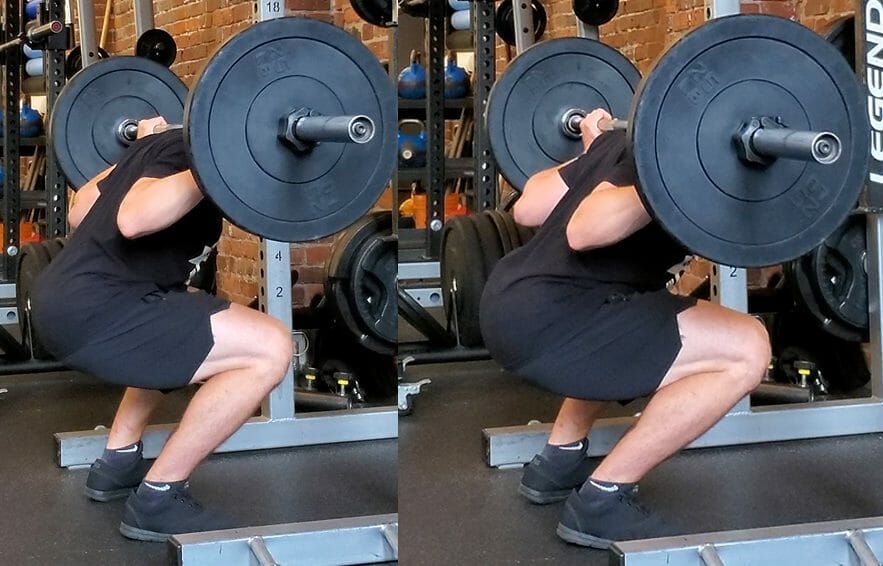As a powerlifter, it can be frustrating when trying to correct your form on a squat, especially when you feel like you no sooner correct one issue and there is another one to correct. As coaches, we see a lot of common trends while working with athletes, and we will generally follow a hierarchy of importance while training. Today’s article is aimed at outlining my priorities (in order of importance) when working with a powerlifter or other strength athlete on their squats by taking a look at the 5 key points that I consider essential to a good squat: unloaded movement, maintaining abdominal pressure, ankle mobility, thoracic mobility, and modifying torso angles for a lower bar position.
1) Squatting Sans-Bar
One of the prerequisites of loaded movement is having good unloaded movement first. Ensure that you can squat with your desired form first, before adding a barbell.
Learning to brace well for a powerlifting squat will help, but general coordination drills like stick training and/or isometrics are excellent building blocks to a good squat performance.
2) Creating and Maintaining IAP Throughout the Squat.
Once you have the basic mobility and coordination to perform an unloaded squat, adding load becomes much simpler. We want to ensure you can create and maintain good IAP through the setup, descent, and ascent of each repetition. Quite often we will see lifters who can brace well in the start position but the moment they get near the bottom of the lift, or even start the descent, they will collapse and lose pressure. This generally results in some wonky looking squat mechanics like heels lifting (without a mobility restriction), excessive forward lean, and hip shift. Using loaded tempo and isometric work to correct identified “technique weak points” is a valuable tool.
3) Ankle Mobility
While I don’t generally use a lot of traditional mobility work (i.e. static stretching), I do feel that if you only check one joint for mobility in the squat, the ankles are a worthwhile contender for that check. With an ankle restriction, it can often make the squat look like it is limited at the hip on one or both sides, as well as impact the general coordination of the lifter as there is a TON of information that comes through your feet. If you can’t interface well with the ground, you’re not going to move as efficiently as possible.
a. Many lifters actually possess adequate ankle mobility but don’t understand how to use the feet properly. This results in the appearance of a deficit, when in reality, there is a lack of skill. We outline how to use your feet properly in the video above.
b. Powerifting or Olympic Lifting shoes are a useful tool for teaching the lifter to use their forefoot and put them into a generally stronger position for the squat. If there is a true mobility deficiency at the ankles, dedicated mobility work such as loaded eccentric is an effective strategy that tends to “stick” better than just static stretching.
On top of the points of focus outlined above, with the low bar squat especially, we tune into a couple more details.

4) Thoracic and Shoulder Mobility
Due to the more “extreme” nature of bar position in the low bar squat, ensuring that the lifter takes a hand placement that works well with their upper back and shoulder mobility is essential to maintaining good mechanics, as without the movement in the above joints, there will be compensation that can throw off the whole system.
Your hand position and bar position should allow you to get upper back tightness without needing to elevate or depress the ribcage significantly from how you high bar squat. Use a wider hand placement if they do.
5) Maximizing Efficiency With Different Leverages.
The lower bar position creates a shorter lever from the bar to the hips. In effect, this allows the lifter to have greater leverage over the bar which is why it is very commonly used in Powerlifting. That being said, it does mean the lifter needs to modify their position (torso, knee, and hip angle) as they transition to a low bar squat because they are squatting with a functionally shorter torso, and so the center of mass shifts.
We are still looking for a bar over mid foot, but in order for the lifter to get there, they will need to lean forwards more (hip hinge), have more forward knee travel, or a combination of both when hitting depth. Generally speaking, most lifters do best with an increased torso angle, provided they can maintain proper IAP when doing so.
There you have it: 5 key points to consider when correcting your squats. Aim to pick one or two pieces from this article to work on, master them, and then move on to the next piece. Trying to learn all of these at once is a sure fire way to frustrate yourself and get nowhere. Rome wasn’t built in a day.
PS – Here’s 3 ways I can help you get stronger:
3. Apply to join my “Momentum Program” and become a case study. We’ll work with you 1-on-1 (in-person or online, depending on location) to consistently increase your PRs.
It takes less than 60 seconds to apply HERE in order to find out more information and see if you’d be a good fit.